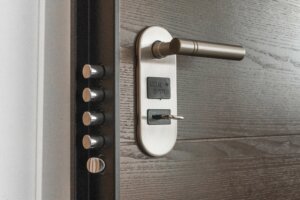Surely nothing is more important than ensuring safety in educational settings, so when it comes to choosing the right spot for your ongoing studies, be sure to opt for a safe place. Whether you are considering a university, college, or vocational school, it’s essential to prioritize your personal well-being and security. While the sizes of educational institutions can vary significantly, the importance of safety remains constant.
Here, we’ll explore some valuable tips to help you choose a safe place for your educational journey, considering factors such as campus security, access control, and the presence of security personnel.

1. Campus Security and Access Control
When evaluating potential institutions for further study, it’s vital to do a little digging regarding their security measures and protocols. With millions in school security grant funding available for educational institutes, schools should now not be compromising on security, and you should not be too.
Access control is an essential element in maintaining a safe educational environment. These systems can include keycard access, biometric scanners, or other secure methods that only restrict entry to authorized individuals. By implementing access control measures such as these, institutions can effectively manage who enters their premises, significantly reducing the risk of unauthorized individuals disrupting the educational environment.
Another crucial aspect to consider is the presence of campus security. A safe, educational environment should have well-trained security personnel who are readily available to handle any potential issues or emergencies that may arise. Look for institutions that have dedicated security staff patrolling the premises, maintaining a visible and vigilant presence. These security personnel can act as a deterrent to any unwanted activity and provide a sense of security for students, faculty, and staff.
It’s also important to note that smaller school settings do not warrant any less attention to security; at the United Career Institute, we understand the significance of safety even within a smaller educational setting. While we don’t have sprawling campus premises, we still prioritize the safety of our students, faculty, and staff. To gain access to our premises, individuals must possess a valid ID or be buzzed in by personnel authorized to grant entry to those who qualify.
2. Digital Safety
In addition to physical security measures, it’s becoming increasingly vital to consider the safety of digital resources and personal information. Institutions must prioritize cybersecurity, given the soaring reliance on technology in the educational sector. Look for institutions that feature robust cybersecurity measures to protect sensitive data; this ensures that your personal information remains confidential and reduces the risk of identity theft or other cybercrimes.
3. Firsthand Feedback
Don’t hesitate to reach out to current or former students of the institution you are considering; there’s nothing more valuable than first-hand feedback, experiences, and insights to give you a real sense of the institution’s safety measures and overall environment. Online forums and social media groups dedicated to education can serve as valuable platforms for connecting with students and gleaning information regarding specific facilities. It’s always a good idea to hone your communication skills, so get chatting!
4. Emergency Preparedness
As well as preventative measures, be sure to check the availability of emergency response plans and procedures. Inquire about the institution’s preparedness in handling emergencies, such as natural disasters, medical emergencies, or safety threats; a well-defined emergency response plan demonstrates the institution’s commitment and competency as to the safety and well-being of its students and staff.
5. Surrounding Neighborhood
It’s also crucial to assess the surrounding neighborhood in which an institution is located. Research the local crime rates and consider the overall safety of the community. While a safe campus is important, the surrounding area should also provide a secure environment for students who commute to and from the school; look for institutions located in well-lit areas with low crime, accessible public transportation options, good surveillance, and police presence, etc.
6. Inclusivity and Respect
Another aspect to consider is an institution’s commitment to fostering a culture of inclusivity and respect; a safe educational environment goes beyond physical security measures, extending to the active promotion of well-being and a sense of belonging for all students. Inquire about an institution’s policies and initiatives that address diversity, equity, and inclusion.
6. Counseling and Support Services
It can also be beneficial to explore an institution’s counseling and student support services; after all, pursuing education can be demanding, and having access to mental health resources can become crucial. Inquire about the availability of counseling services, student support programs, and wellness initiatives; institutions that prioritize the mental health and support of their students contribute to a safer and more nurturing educational environment.

7. Track Record and Reputation
Consider an institution’s track record and reputation regarding safety, researching any past incidents or safety concerns and evaluating how the institution handled them. Look for institutions that demonstrate transparency and proactive measures in addressing safety issues. Institutions that prioritize continuous improvement and are highly responsive to safety concerns provide an added level of assurance that all students deserve.
8. Trust Your Instincts
Lastly, trust your instincts when visiting potential institutions; pay attention to your gut feeling and assess whether you feel comfortable and secure on the campus in question. Take note of the overall atmosphere, the interactions between students and staff, and the general cleanliness and maintenance of the facilities – these subtle cues can provide a wealth of insights into the institution’s overall commitment to the safety and well-being of its community.
Final Thoughts
There are many factors that are understandably important when it comes to selecting a safe place for your ongoing education – and security is one that mustn’t be overlooked. By following these tips, you can make an informed decision and embark on an ongoing educational journey with some much-needed peace of mind.
